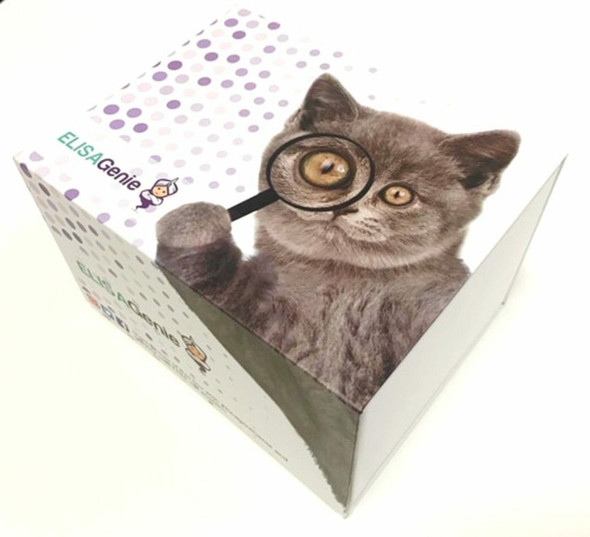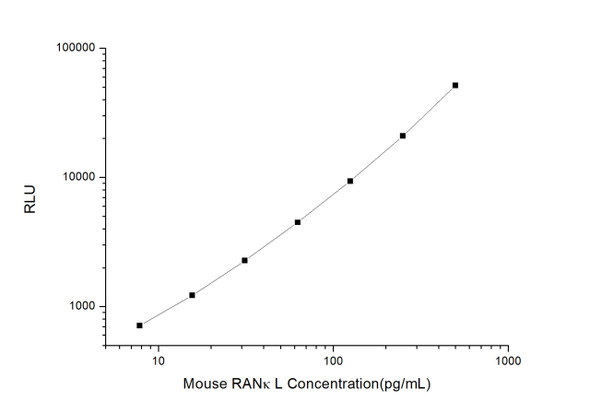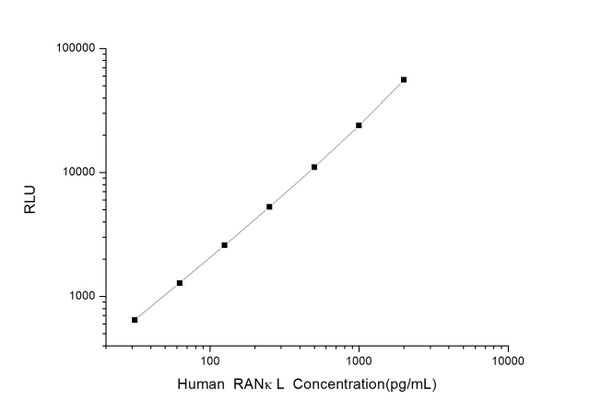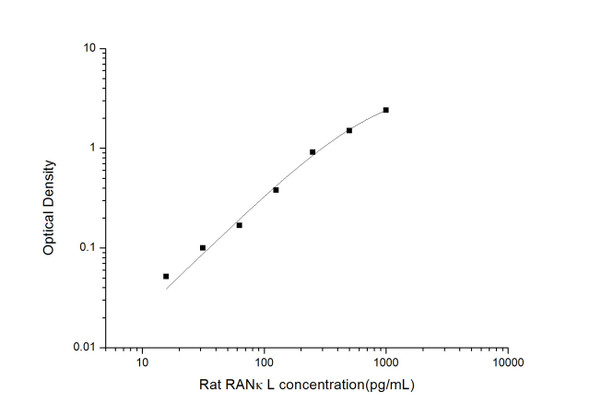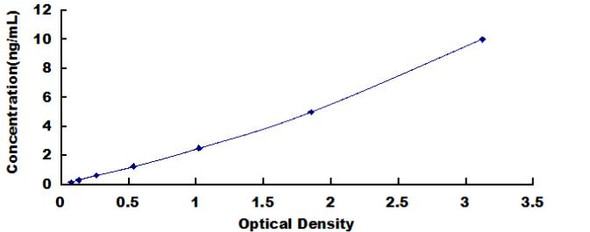Rat Signaling ELISA Kits 3
Rat RANkL (Receptor Activator of Nuclear Factor Kappa B Ligand) CLIA Kit (RTES00498)
- SKU:
- RTES00498
- Product Type:
- ELISA Kit
- ELISA Type:
- CLIA Kit
- Size:
- 96 Assays
- Sensitivity:
- 4.69pg/mL
- Range:
- 7.81-500pg/mL
- ELISA Type:
- Sandwich
- Synonyms:
- TNFSF11, TRANCE, RANKL, CD254, ODF, OPGL, OPTB2, hRANKL2, sOdf
- Reactivity:
- Rat
- Sample Type:
- Serum, plasma and other biological fluids
- Research Area:
- Developmental Biology
Description
| Assay type: | Sandwich |
| Format: | 96T |
| Assay time: | 4.5h |
| Reactivity: | Rat |
| Detection method: | Chemiluminescence |
| Detection range: | 7.81-500 pg/mL |
| Sensitivity: | 4.69 pg/mL |
| Sample volume: | 100µL |
| Sample type: | Serum, plasma and other biological fluids |
| Repeatability: | CV < 15% |
| Specificity: | This kit recognizes Rat RANkL in samples. No significant cross-reactivity or interference between Rat RANkL and analogues was observed. |
This kit uses Sandwich-CLIA as the method. The micro CLIA plate provided in this kit has been pre-coated with an antibody specific to Rat RANkL. Standards or samples are added to the appropriate micro CLIA plate wells and combined with the specific antibody. Then a biotinylated detection antibody specific for Rat RANkL and Avidin-Horseradish Peroxidase (HRP) conjugate are added to each micro plate well successively and incubated. Free components are washed away. The substrate solution is added to each well. Only those wells that contain Rat RANkL, biotinylated detection antibody and Avidin-HRP conjugate will appear fluorescence. The Relative light unit (RLU) value is measured spectrophotometrically by the Chemiluminescence immunoassay analyzer. The RLU value is positively associated with the concentration of Rat RANkL. The concentration of Rat RANkL in the samples can be calculated by comparing the RLU of the samples to the standard curve.
| UniProt Protein Function: | Cytokine that binds to TNFRSF11B/OPG and to TNFRSF11A/RANK. Osteoclast differentiation and activation factor. Augments the ability of dendritic cells to stimulate naive T-cell proliferation. May be an important regulator of interactions between T-cells and dendritic cells and may play a role in the regulation of the T-cell-dependent immune response. May also play an important role in enhanced bone-resorption in humoral hypercalcemia of malignancy. Induces osteoclastogenesis by activating multiple signaling pathways in osteoclast precursor cells, chief among which is induction of long lasting oscillations in the intracellular concentration of Ca (2+) resulting in the activation of NFATC1, which translocates to the nucleus and induces osteoclast-specific gene transcription to allow differentiation of osteoclasts. During osteoclast differentiation, in a TMEM64 and ATP2A2-dependent manner induces activation of CREB1 and mitochondrial ROS generation necessary for proper osteoclast generation. |
| NCBI Summary: | induces osteoclast formation and bone resoprtion; plays a role in regulation of calcium homeostasis and osteoclast function [RGD, Feb 2006] |
| UniProt Code: | Q9ESE2 |
| NCBI GenInfo Identifier: | 21362971 |
| NCBI Gene ID: | 117516 |
| NCBI Accession: | Q9ESE2. 1 |
| UniProt Secondary Accession: | Q9ESE2,Q91ZI9, |
| UniProt Related Accession: | Q9ESE2 |
| Molecular Weight: | 35,370 Da |
| NCBI Full Name: | Tumor necrosis factor ligand superfamily member 11 |
| NCBI Synonym Full Names: | tumor necrosis factor (ligand) superfamily, member 11 |
| NCBI Official Symbol: | Tnfsf11 |
| NCBI Official Synonym Symbols: | RANKL |
| NCBI Protein Information: | tumor necrosis factor ligand superfamily member 11; ODF; OPGL; TRANCE; osteoprotegerin ligand; osteoclast differentiation factor; TNF-related activation-induced cytokine; receptor activator of nuclear factor kappa B ligand; receptor activator of nuclear factor kappa-B ligand |
| UniProt Protein Name: | Tumor necrosis factor ligand superfamily member 11 |
| UniProt Synonym Protein Names: | Osteoclast differentiation factor; ODF; Osteoprotegerin ligand; OPGL; Receptor activator of nuclear factor kappa-B ligand; RANKL; TNF-related activation-induced cytokine; TRANCE; CD_antigen: CD254Cleaved into the following 2 chains:Tumor necrosis factor ligand superfamily member 11, membrane form; Tumor necrosis factor ligand superfamily member 11, soluble form |
| UniProt Gene Name: | Tnfsf11 |
| UniProt Entry Name: | TNF11_RAT |
As the RLU values of the standard curve may vary according to the conditions of the actual assay performance (e. g. operator, pipetting technique, washing technique or temperature effects), the operator should establish a standard curve for each test. Typical standard curve and data is provided below for reference only.
| Concentration (pg/mL) | RLU | Average | Corrected |
| 500 | 50963 52111 | 51537 | 51508 |
| 250 | 20120 21876 | 20998 | 20969 |
| 125 | 9583 9209 | 9396 | 9367 |
| 62.5 | 4425 4599 | 4512 | 4483 |
| 31.25 | 2316 2282 | 2299 | 2270 |
| 15.63 | 1333 1167 | 1250 | 1221 |
| 7.81 | 728 752 | 740 | 711 |
| 0 | 28 30 | 29 | -- |
Precision
Intra-assay Precision (Precision within an assay): 3 samples with low, mid range and high level Rat RANkL were tested 20 times on one plate, respectively.
Inter-assay Precision (Precision between assays): 3 samples with low, mid range and high level Rat RANkL were tested on 3 different plates, 20 replicates in each plate.
| Intra-assay Precision | Inter-assay Precision | |||||
| Sample | 1 | 2 | 3 | 1 | 2 | 3 |
| n | 20 | 20 | 20 | 20 | 20 | 20 |
| Mean (pg/mL) | 23.51 | 63.94 | 240.21 | 22.32 | 62.40 | 251.19 |
| Standard deviation | 2.40 | 5.79 | 19.17 | 2.48 | 7.31 | 26.83 |
| C V (%) | 10.21 | 9.06 | 7.98 | 11.11 | 11.71 | 10.68 |
Recovery
The recovery of Rat RANkL spiked at three different levels in samples throughout the range of the assay was evaluated in various matrices.
| Sample Type | Range (%) | Average Recovery (%) |
| Serum (n=5) | 89-101 | 95 |
| EDTA plasma (n=5) | 94-108 | 100 |
| Cell culture media (n=5) | 98-110 | 104 |
Linearity
Samples were spiked with high concentrations of Rat RANkL and diluted with Reference Standard & Sample Diluent to produce samples with values within the range of the assay.
| Serum (n=5) | EDTA plasma (n=5) | Cell culture media (n=5) | ||
| 1:2 | Range (%) | 88-100 | 103-115 | 101-115 |
| Average (%) | 95 | 109 | 109 | |
| 1:4 | Range (%) | 90-103 | 96-111 | 92-106 |
| Average (%) | 96 | 104 | 98 | |
| 1:8 | Range (%) | 87-99 | 88-102 | 88-102 |
| Average (%) | 94 | 93 | 94 | |
| 1:16 | Range (%) | 96-111 | 100-113 | 88-101 |
| Average (%) | 103 | 106 | 95 |
An unopened kit can be stored at 4°C for 1 month. If the kit is not used within 1 month, store the items separately according to the following conditions once the kit is received.
| Item | Specifications | Storage |
| Micro CLIA Plate(Dismountable) | 8 wells ×12 strips | -20°C, 6 months |
| Reference Standard | 2 vials | |
| Concentrated Biotinylated Detection Ab (100×) | 1 vial, 120 µL | |
| Concentrated HRP Conjugate (100×) | 1 vial, 120 µL | -20°C(shading light), 6 months |
| Reference Standard & Sample Diluent | 1 vial, 20 mL | 4°C, 6 months |
| Biotinylated Detection Ab Diluent | 1 vial, 14 mL | |
| HRP Conjugate Diluent | 1 vial, 14 mL | |
| Concentrated Wash Buffer (25×) | 1 vial, 30 mL | |
| Substrate Reagent A | 1 vial, 5 mL | 4°C (shading light) |
| Substrate Reagent B | 1 vial, 5 mL | 4°C (shading light) |
| Plate Sealer | 5 pieces | |
| Product Description | 1 copy | |
| Certificate of Analysis | 1 copy |
- Set standard, test sample and control (zero) wells on the pre-coated plate and record theirpositions. It is recommended to measure each standard and sample in duplicate. Note: addall solutions to the bottom of the plate wells while avoiding contact with the well walls. Ensuresolutions do not foam when adding to the wells.
- Aliquot 100 µL of standard solutions into the standard wells.
- Add 100 µL of Sample / Standard dilution buffer into the control (zero) well.
- Add 100 µL of properly diluted sample (serum, plasma, tissue homogenates and otherbiological fluids. ) into test sample wells.
- Cover the plate with the sealer provided in the kit and incubate for 90 min at 37 °C.
- Aspirate the liquid from each well, do not wash. Immediately add 100 µL of BiotinylatedDetection Ab working solution to each well. Cover the plate with a plate seal and gently mix. Incubate for 1 hour at 37 °C.
- Aspirate or decant the solution from the plate and add 350 µL of wash buffer to each welland incubate for 1-2 minutes at room temperature. Aspirate the solution from each well andclap the plate on absorbent filter paper to dry. Repeat this process 3 times. Note: a microplatewasher can be used in this step and other wash steps.
- Add 100 µL of HRP Conjugate working solution to each well. Cover with a plate seal andincubate for 30 min at 37 °C.
- Aspirate or decant the solution from each well. Repeat the wash process for five times asconducted in step 7.
- Add 100 µL of Substrate mixture solution to each well. Cover with a new plate seal andincubate for no more than 5 min at 37 °C. Protect the plate from light.
- Determine the RLU value of each well immediately.


